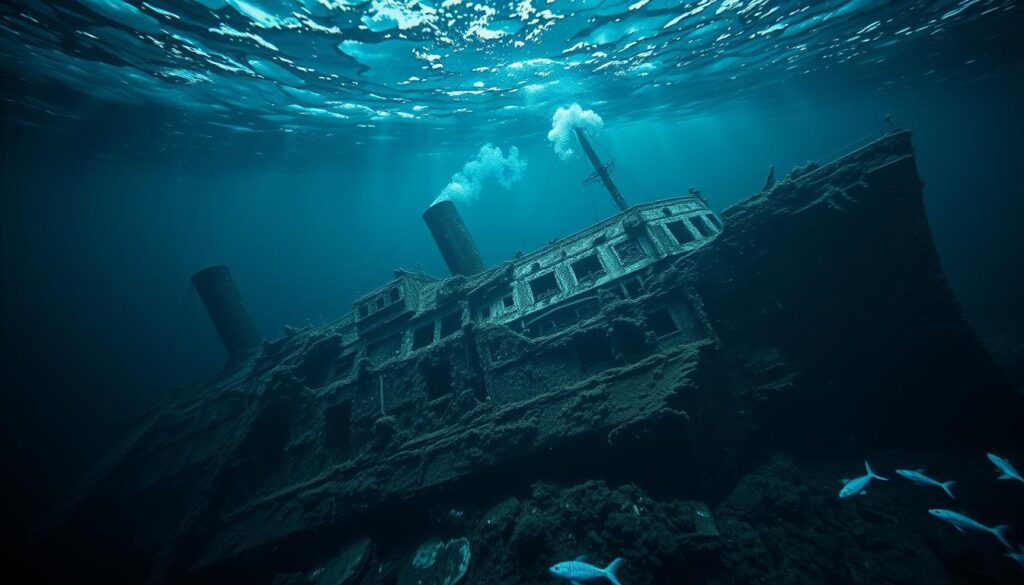The RMS Titanic’s story is a reminder of humanity’s pride and nature’s power. This “unsinkable” ship was seen as the best of the Edwardian era. Yet, it became a symbol of tragedy at sea. As we remember the Titanic’s journey, we wonder: What secrets and lessons lie buried within the wreckage of this legendary ocean liner?
The Titanic’s tale is more than just a ship’s story. It shows the hopes, dreams, and fears of an era. From its creation to its iceberg collision, the Titanic’s journey has fascinated people everywhere. It reminds us of our vulnerability against the sea’s power.
Key Takeaways
- The RMS Titanic was hailed as the “unsinkable” luxury liner that captivated the world during the Edwardian era
- The Titanic’s ill-fated maiden voyage in 1912 resulted in one of the most tragic maritime disasters in history
- The Titanic’s story has endured as a powerful symbol of human hubris and the vulnerability of even the most advanced technology
- The wreckage of the Titanic continues to reveal new insights into the ship’s construction, the events of that fateful night, and the lives of those on board
- The Titanic’s legacy has inspired countless books, films, and investigations, keeping the memory of this iconic vessel alive
Unveiling the Grandeur: The Construction of the RMS Titanic
The RMS Titanic was a marvel of engineering and design. It was built with ambitious dreams and cutting-edge technology. This made many believe it was unsinkable.
Ambitious Dreams and Cutting-Edge Engineering
The White Star Line commissioned the Titanic. It was meant to be the largest, most luxurious ship of its time. Over 15,000 skilled workers used the latest technology to build it.
The Titanic had a double-bottomed hull and watertight compartments. Its designers were sure it could handle any sea condition. This belief added to the unsinkable ship myth.
The White Star Line’s Pursuit of Opulence
The White Star Line spent a lot on the Titanic. They wanted to create the ultimate luxury and comfort for passengers. The ship’s interior showed off the opulence of the Edwardian era.
The Titanic had lavish furnishings and grand staircases. It was designed for the elite, making it the top luxury passenger ship.
“The Titanic was the pride of the White Star Line, a testament to their ambition and the ingenuity of its designers. It was truly a marvel of its time.”
Titanic: The Ill-Fated Voyage of History’s Most Famous ‘Unsinkable’ Ship
The RMS Titanic was seen as the top of maritime engineering and luxury. It set sail in April 1912, exciting the world with its grandeur. It was called “unsinkable” and sailed from Southampton, England, to New York City.
Many people were excited for the Titanic’s journey. Thousands watched as it left, amazed by its size and luxury. The ship had the rich and famous, as well as immigrants, on board. The crew aimed to make the trip safe and memorable.
But, the Titanic’s journey took a bad turn. It hit an iceberg in the North Atlantic. This led to one of the most famous maritime disasters in history. The “unsinkable” myth was broken, and the Titanic’s tragic story is now known worldwide.
“The Titanic was the ship of dreams, and it was. It really was.”

Maiden Voyage: Embarking on a Journey into History
The launch of the RMS Titanic in 1912 marked a new era in maritime luxury and technology. As the Titanic set sail, excitement and anticipation filled the air. Both passengers and crew were captivated by the moment.
The Excitement and Anticipation
The Titanic was seen as an unsinkable ship, the pride of the White Star Line. It showcased the ingenuity of the Edwardian era. Passengers were eager to see the ship’s opulence, unaware of the tragedy that awaited them.
Passengers and Crew: A Microcosm of Society
The Titanic was a reflection of society, with people from all walks of life on board. First-class passengers enjoyed luxury, while those in steerage had simpler accommodations. The diverse crew worked hard to keep the ship running smoothly.
The Fateful Encounter: Iceberg Collision and its Consequences
The RMS Titanic, a symbol of the Edwardian era, sailed through the North Atlantic’s dark waters. On April 14, 1912, it hit a massive iceberg. This event marked a tragic moment in maritime history.
The first hit was almost unnoticeable to those on the Titanic. But soon, the ship started taking on water. The crew knew they faced a disaster.
The Titanic was seen as unsinkable, thanks to its advanced design. But its flaws and lack of lifeboats were its downfall. This left everyone on board fighting for their lives.
“The iceberg struck the starboard side of the ship, opening up the first five compartments to the sea. The ship was doomed.”
As the Titanic sank, panic spread. Passengers and crew tried to grasp the disaster unfolding before them. The Titanic‘s voyage ended in tragedy, affecting many for generations.

The Titanic sinking reminds us of human endeavors’ fragility and the sea’s power. This shipwreck and loss of over 1,500 lives shattered the “unsinkable” myth. The Titanic now symbolizes human ambition and nature’s force.
Sinking into Oblivion: The Titanic’s Final Hours
The RMS Titanic, known as the “unsinkable” ship, hit an iceberg and quickly turned into chaos. Passengers and crew fought for survival as the ship sank. The Titanic’s last hours were filled with bravery and tragedy, forever changing maritime history.
Chaos, Courage, and Heroic Acts
The iceberg hit the Titanic, causing shockwaves. Soon, everyone knew the ship was doomed. Panic grew as people rushed to get on lifeboats. Crew members worked hard to save as many lives as they could.
In the chaos, stories of bravery and sacrifice came to light. People risked their lives to help others escape. The Titanic’s sinking showed the strength of the human spirit. It was a time of courage and selflessness, inspiring many.

